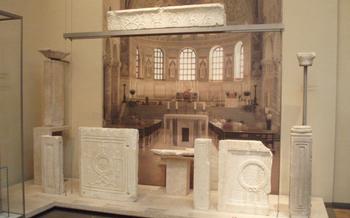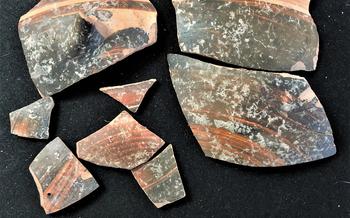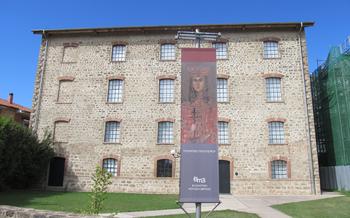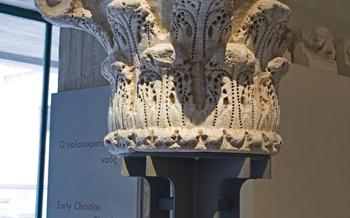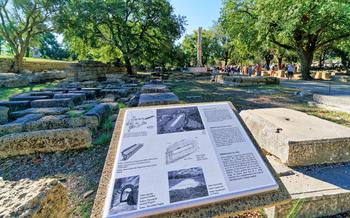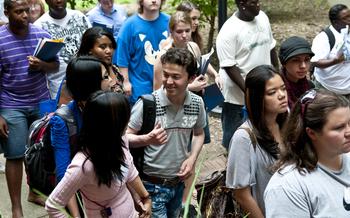
Byzantine Museum of Kastoria
- Historical Background
- Location and Accessibility
- Architectural Marvel
- Permanent Collection
- Temporary Exhibitions
- Educational Programs
- Byzantine Art Workshops
- Research Facilities
- Museum Shop
- Accessibility
- Admission and Hours of Operation
- Photography and Videography
- Guided Tours
- Events and Workshops
- Insider Tip
Historical Background
Nestled in the heart of the picturesque city of Kastoria, Greece, the Byzantine Museum stands as a testament to the region's rich cultural heritage. The museum's history is deeply intertwined with the city's own, dating back to the Byzantine Empire, which ruled over Kastoria from the 9th to the 15th century. During this period, Kastoria flourished as a significant center of Byzantine art and culture, leaving behind a legacy of stunning churches, monasteries, and other architectural marvels.
The Byzantine Museum was established in 1989 to showcase the region's remarkable collection of Byzantine artifacts. Housed in a beautifully restored 19th-century mansion, the museum offers visitors a unique glimpse into the artistic and cultural achievements of the Byzantine Empire. Its collection encompasses a diverse range of objects, including icons, frescoes, manuscripts, sculptures, and liturgical objects, providing a comprehensive overview of Byzantine art and history.
Location and Accessibility
The Byzantine Museum of Kastoria is conveniently located in the heart of the city, at 1 Nikis Street, making it easily accessible to visitors. The museum is situated within walking distance of many of the city's other attractions, including the picturesque Old Town with its narrow cobblestone streets and traditional Macedonian houses.
For those arriving by public transportation, the museum is within easy reach of the main bus station and taxi ranks. There are several bus lines that stop nearby, including lines 1, 2, and Alternatively, visitors can opt to take a leisurely stroll through the city center, enjoying the vibrant atmosphere and local shops along the way.
For those traveling by car, there are limited parking options available on the streets surrounding the museum. However, there are several public parking lots within a short walking distance, ensuring that visitors can find a convenient spot to leave their vehicles.
Architectural Marvel
The Byzantine Museum of Kastoria is housed in a magnificent 19th-century building that is a testament to the region's rich architectural heritage. Originally built as a school, the structure showcases a blend of Byzantine and neoclassical elements, reflecting the architectural transition that occurred during that period.
The museum building boasts intricate stone carvings, arched windows, and a grand entrance that sets the tone for the treasures within. Its spacious interior features high ceilings, elegant chandeliers, and polished marble floors, creating a majestic ambiance for displaying the Byzantine artifacts.
The historical significance of the building adds to its allure. It served as a symbol of education and cultural advancement during its time as a school, and its transformation into a museum has preserved and celebrated the region's Byzantine heritage. Visitors can't help but feel a sense of awe and reverence as they step into this architectural masterpiece, which stands as a beacon of Byzantine art and history in Kastoria.
Permanent Collection
The Byzantine Museum of Kastoria houses a captivating permanent collection that takes visitors on a journey through the artistic and cultural heritage of the Byzantine Empire. The museum showcases an array of artifacts that vividly illustrate the evolution of Byzantine art and its profound influence on the region.
Among the highlights of the collection is an exquisite collection of icons, regarded as masterpieces of Byzantine artistry. These icons, created on wood or canvas, depict religious figures with intricate details and vibrant colors, reflecting the deep devotion and reverence of the Byzantine people.
The museum also features a remarkable collection of manuscripts and codices, providing a glimpse into the literary and intellectual achievements of the Byzantine era. These manuscripts, meticulously handwritten on parchment, contain texts ranging from religious scriptures to historical chronicles, offering insights into the intellectual pursuits and spiritual beliefs of the Byzantine civilization.
In addition to icons and manuscripts, the museum boasts a diverse collection of sculptures, mosaics, and frescoes that further enrich the storytelling of Byzantine art. These artworks, often depicting scenes from the Bible or the lives of saints, demonstrate the exceptional skill and craftsmanship of Byzantine artists, who transformed ordinary materials into objects of extraordinary beauty and spiritual significance.
The permanent collection of the Byzantine Museum of Kastoria offers an immersive experience, allowing visitors to explore the history, culture, and artistic traditions of the Byzantine Empire. Through these artifacts, visitors gain a deeper understanding of the enduring legacy of Byzantium and its significant contributions to the development of art and civilization in the Mediterranean region.
Temporary Exhibitions
The Byzantine Museum of Kastoria occasionally hosts temporary exhibitions that showcase contemporary Byzantine art and artifacts. These exhibitions provide a platform for emerging and established artists to present their works and contribute to the ongoing dialogue surrounding Byzantine art and its relevance in the modern world. The temporary exhibitions are curated by experts in the field and often feature a diverse range of artistic expressions, including paintings, sculptures, mosaics, and other forms of Byzantine-inspired artwork.
These exhibitions not only offer visitors a fresh perspective on Byzantine art but also serve as a bridge between the past and the present. They highlight the enduring influence of Byzantine aesthetics and techniques in contemporary art practices, demonstrating how Byzantine art continues to inspire and inform artists today. Additionally, the temporary exhibitions provide a unique opportunity for visitors to engage with contemporary interpretations of Byzantine history and culture.
Educational Programs
The Byzantine Museum of Kastoria is committed to promoting education and fostering a deeper understanding of Byzantine art and history. To this end, the museum offers a range of educational programs tailored to visitors of all ages and interests.
Workshops and Lectures Throughout the year, the museum hosts workshops and lectures that delve into various aspects of Byzantine art and culture. These sessions are led by renowned scholars, historians, and artists who share their expertise and insights with the public. Topics covered in these programs include the history of Byzantine art, the techniques and materials used by Byzantine artists, and the symbolism and iconography of Byzantine iconography.
Guided Tours For visitors who wish to delve deeper into the museum's collection, guided tours are available upon request. Led by knowledgeable museum docents, these tours provide an in-depth exploration of the museum's highlights, offering insights into the historical and cultural context of the artworks. Visitors can learn about the artistic styles and techniques of different periods, the lives of the artists, and the significance of the religious and secular themes depicted in the artworks.
Educational Resources The museum also offers a range of educational resources for students and researchers. These include a well-stocked library with a vast collection of books, journals, and articles on Byzantine art and history. Additionally, the museum has an archive that houses a wealth of primary source material, such as manuscripts, letters, and documents related to Byzantine history and culture.
Byzantine Art Workshops
The Byzantine Museum of Kastoria offers a unique opportunity for visitors to immerse themselves in the art of the Byzantine era through hands-on workshops. These workshops provide a chance to learn about the techniques and traditions of Byzantine art and create your own Byzantine-style artwork.
Participants in the workshops can choose from a variety of activities, such as icon painting, manuscript illumination, and jewelry making. Experienced instructors guide participants through the process, providing instruction on the techniques and materials used in Byzantine art.
The workshops are suitable for people of all skill levels, from beginners to experienced artists. They offer a fun and educational way to learn about Byzantine art and create a unique souvenir to take home.
The workshops are typically held on weekends and during the summer months. Visitors can find more information about the workshops and how to register on the museum's website or by contacting the museum directly.
These workshops are an excellent way to get a deeper understanding of Byzantine art and create a unique and meaningful souvenir. They are a must-do for anyone interested in Byzantine culture and history.
Research Facilities
The Byzantine Museum of Kastoria houses a comprehensive research library and archives, providing an invaluable resource for scholars and researchers studying Byzantine art and history. The library boasts an extensive collection of books, journals, and periodicals dedicated to Byzantine studies, offering a wealth of knowledge and insights into this fascinating period. Additionally, the archives contain a treasure trove of primary source documents, including manuscripts, charters, and other historical records, which provide firsthand accounts of the Byzantine Empire's rich history and culture. These resources make the Byzantine Museum of Kastoria a hub for scholarly research, enabling researchers to delve deeper into the complexities of Byzantine art and history.
Museum Shop
The Byzantine Museum of Kastoria houses a well-stocked museum shop that offers a range of souvenirs, books, and replicas of Byzantine artifacts. Visitors can find a variety of items to commemorate their visit, including postcards, magnets, and keychains featuring images of the museum's iconic exhibits.
For those interested in delving deeper into Byzantine art and history, the museum shop offers a selection of books and catalogs that explore various aspects of Byzantine culture. These publications provide insights into the techniques, styles, and historical context of Byzantine art, allowing visitors to further their understanding and appreciation.
Additionally, the museum shop sells replicas of Byzantine artifacts, such as jewelry, pottery, and small sculptures. These replicas are carefully crafted to resemble the originals, offering visitors the chance to own a piece of Byzantine history. Whether you're looking for a unique souvenir or a gift for a loved one, the Byzantine Museum of Kastoria's museum shop has something for everyone.
Accessibility
The Byzantine Museum of Kastoria is committed to providing an accessible and inclusive environment for all visitors. The museum is fully wheelchair accessible, with ramps and elevators available to facilitate easy movement throughout the building. Accessible restrooms are also available on-site. Visitors with disabilities are encouraged to contact the museum in advance to request any additional accommodations or assistance they may require. The museum staff is dedicated to ensuring that all visitors have a positive and enjoyable experience at the Byzantine Museum of Kastoria.
Admission and Hours of Operation
Admission to the Byzantine Museum of Kastoria is free of charge for all visitors, making it an accessible and inclusive cultural destination. This generous policy encourages people from all backgrounds to explore and appreciate the museum's rich collection.
The museum's hours of operation are as follows:
- Summer Season (April 1st - October 31st)
-
Tuesday to Sunday: 08:00 AM - 08:00 PM
-
Winter Season (November 1st - March 31st)
- Tuesday to Sunday: 08:00 AM - 03:00 PM
Please note that the museum is closed on Mondays throughout the year. It is also closed on certain public holidays, so it is advisable to check the museum's website for any updates or changes before planning your visit.
Photography and Videography
The Byzantine Museum of Kastoria encourages visitors to capture their experiences through photography and videography. However, to ensure the preservation of the artifacts and the overall museum environment, certain guidelines must be followed:
-
Flash Photography Prohibited: The use of flash photography is strictly prohibited within the museum. Flash can damage the delicate pigments and materials of the artifacts, leading to their deterioration over time.
-
Tripods and Monopods: Tripods and monopods are generally not permitted inside the museum. These accessories can obstruct the movement of other visitors and may pose a safety hazard in the confined spaces of the galleries.
-
Respectful Documentation: Visitors are encouraged to document their visit through photographs and videos, but they must do so respectfully. Taking pictures of other visitors without their consent or disturbing the museum's peaceful atmosphere is not allowed.
-
Commercial Use: Any commercial use of photographs or videos taken within the museum requires prior written permission from the museum administration. This includes using images for publications, marketing materials, or online sharing for commercial gain.
By following these guidelines, visitors can contribute to the preservation of the Byzantine Museum of Kastoria's priceless collection while also sharing their experiences with others in a responsible manner.
Guided Tours
The Byzantine Museum of Kastoria offers guided tours to enhance visitors' understanding and appreciation of its collection. These tours provide insightful commentary on the historical and cultural significance of the artifacts, allowing visitors to delve deeper into the rich history of Byzantine art. Guided tours are available in various languages, including English, Greek, and French, to cater to a diverse audience.
For groups, pre-booking is recommended to ensure the availability of a guide and to avoid any inconvenience. The museum offers special rates for group bookings, making it an excellent option for educational institutions and cultural organizations.
Whether you're an art enthusiast or simply curious about Byzantine history, a guided tour of the Byzantine Museum of Kastoria is an enriching experience that will leave you with a deeper understanding of this remarkable chapter in human history.
Events and Workshops
The Byzantine Museum of Kastoria actively engages with the community and visitors through a range of events and workshops. These programs provide opportunities for deeper exploration of Byzantine art, culture, and history.
Throughout the year, the museum hosts temporary exhibitions that showcase the works of contemporary artists inspired by Byzantine aesthetics and techniques. These exhibitions offer a fresh perspective on Byzantine art and its relevance to modern artistic practices.
In addition, the museum organizes educational workshops for children and adults, allowing participants to immerse themselves in the art of Byzantium. These workshops cover various topics, including icon painting, manuscript illumination, and mosaic making. Participants have the chance to learn about the traditional techniques and create their own Byzantine-style artwork to take home.
The museum also collaborates with local universities and institutions to host lectures, seminars, and conferences on Byzantine art and history. These events bring together scholars, researchers, and enthusiasts to share their knowledge and insights on various aspects of Byzantine culture.
By participating in these events and workshops, visitors can gain a deeper understanding of Byzantine art and history, engage with contemporary interpretations of Byzantine aesthetics, and create their own Byzantine-inspired artwork.
Insider Tip
To fully appreciate the Byzantine Museum of Kastoria, plan your visit during the off-season, typically between November and March. The cooler temperatures and fewer crowds will allow you to immerse yourself in the museum's collection without distractions. This is an excellent time to engage with the museum's knowledgeable staff, who are always eager to share their insights and stories about the exhibits.
While exploring the museum, keep an eye out for the hidden gem of the collection: a rare and exquisite 12th-century icon depicting the Virgin Mary with Child. This masterpiece, often overlooked amidst the museum's other treasures, is a testament to the exceptional craftsmanship and artistic brilliance of the Byzantine era. Don't miss the opportunity to marvel at its intricate details and vibrant colors, which have been meticulously preserved over the centuries.
